Study shows scaling up mRNA vaccines for lower-income countries is affordable and could save millions of lives
When it comes to COVID-19, no-one is safe until everyone is safe. A new study suggests vaccinating countries that haven’t had good access to vaccines so faris necessary to stop the virus continuing to evolve into new, potentially deadlier, variants.
- 23 February 2022
- 3 min read
- by Priya Joi

What is the research about?
While nearly two-thirds of the world has received at least one dose of COVID-19 vaccine, distribution has not been equitable. The most vulnerable countries have received very few vaccines. Just 4% of people in low-income countries is fully vaccinated, compared with over 70% in high-income nations. But this doesn’t have to be the case. This paper aims to estimate the number of deaths that could be averted by rapidly scaling up vaccination in low and lower-middle income countries.
“Given the magnitude of expected mortality facing these countries without vaccination, this effort should be an urgent priority.”
What did the researchers do?
The researchers, publishing their data in a preprint, ran models using public data on global vaccination and COVID-19 deaths. They analysed vaccination scenarios involving either two or three doses of mRNA vaccines and looked at vaccine-preventable deaths. They also used estimates of the total cost of vaccine manufacturing and delivery to calculate the cost per death averted.
What did they find?
They found that scaling up vaccination saves lives and money, with dramatic results.Providing two doses of mRNA vaccine to everyone in lower-income countries would cost US$ 35.5 billion and avert 1.3 million deaths from COVID-19, at a cost of US$ 26,900 per death averted. Providing three doses would increase the cost to US$ 61.2 billion and avert 1.5 million deaths from COVID-19, at a cost of US$ 40,800 per death averted.
For the two-dose scenario, reducing vaccine uptake to 75% would avert one million deaths at a cost of US$ 25,900 per death averted. For the three-dose scenario, 1.2 million deaths would be prevented at a cost of US$ 53,400 per death averted.
Have you read?
They created a scenario in which Omicron infects 100% of the population before vaccination is available, since this variant is spreading faster than the speed at which everyone could be vaccinated. In this scenario, the risk of death is from re-infection of people who have only partial natural immunity. In this case, the three-dose scenario with natural immunity protection against mortality of 80% would save half a million lives at a cost-per-death averted of US$ 115,000.
What does this mean?
The analysis suggests that scale-up of vaccination in low- and lower-middle income countries is achievable at justifiable cost, and the authors say “given the magnitude of expected mortality facing these countries without vaccination, this effort should be an urgent priority”.









